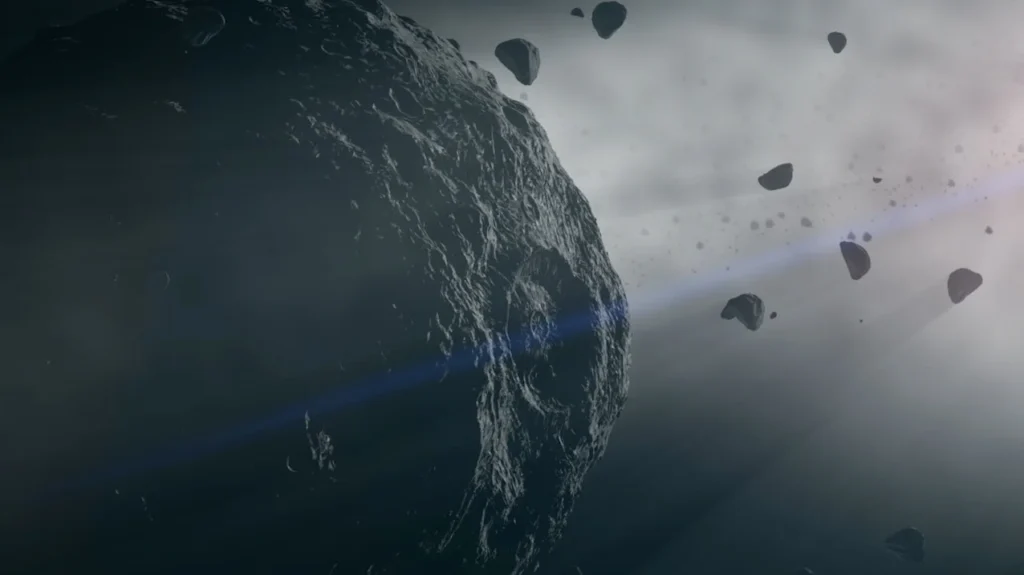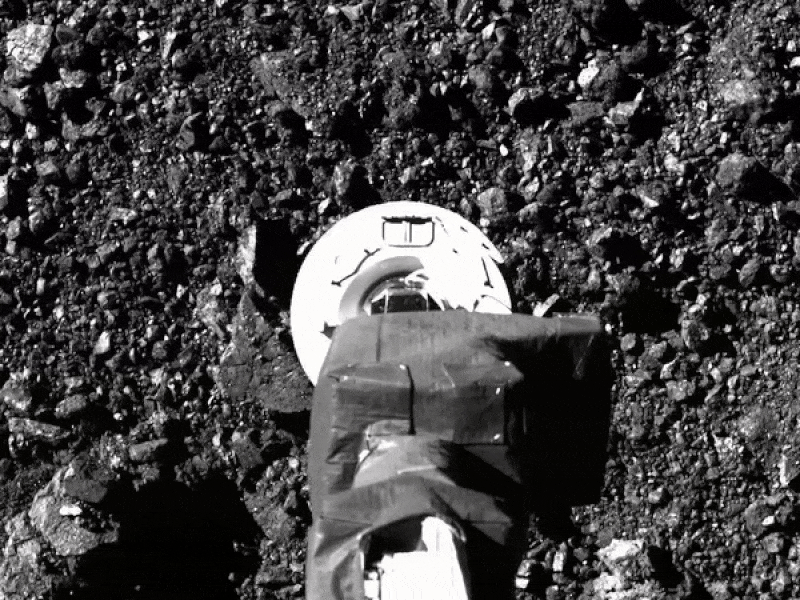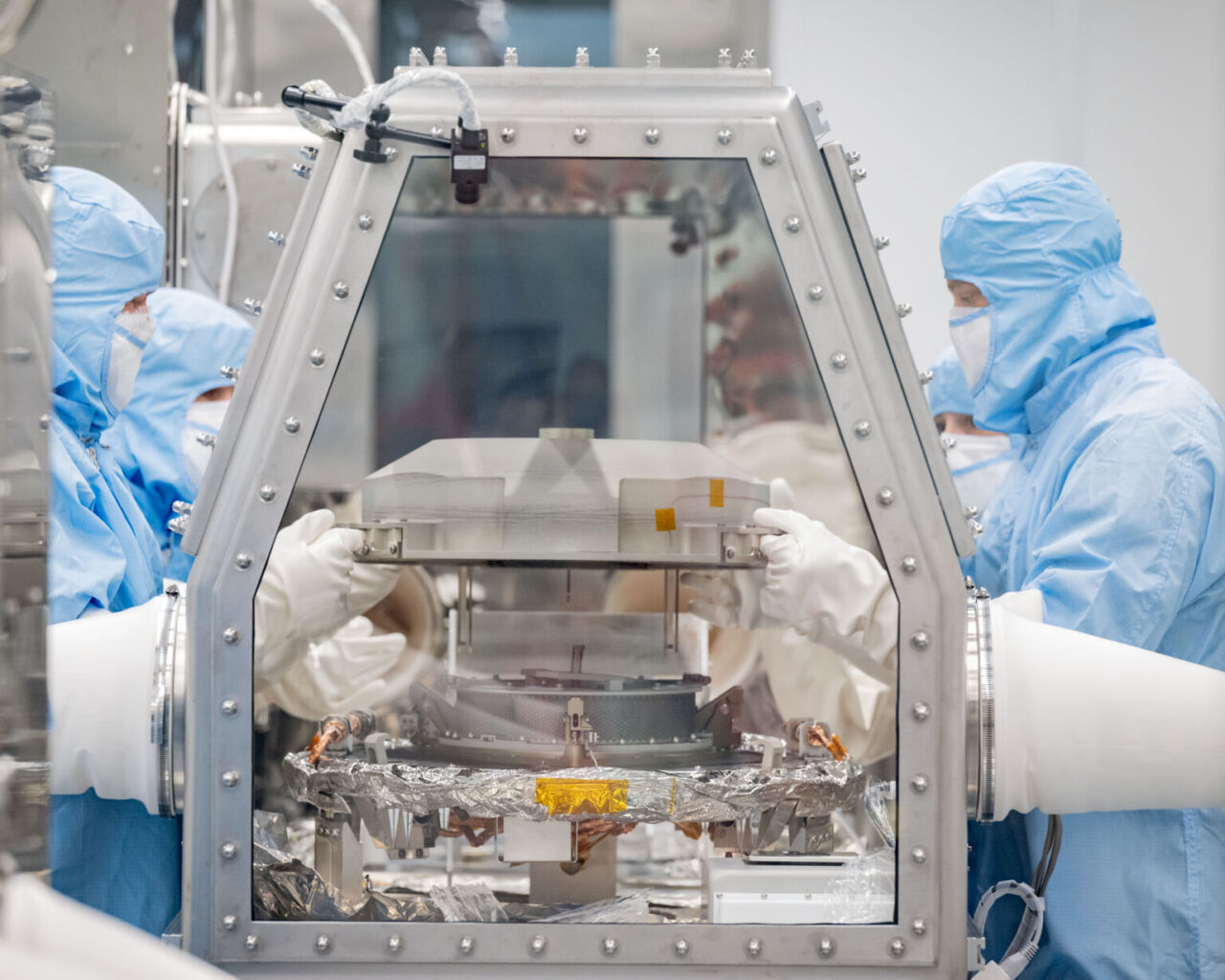The OSIRIS-REx mission, launched by NASA, is a historic mission to explore the near-Earth asteroid Bennu. It has been a key part of NASA’s effort to understand the building blocks of our solar system. But where is OSIRIS-REx now and what has it done? Let’s get up to date and look at the mission’s major milestones.
Mission Overview
The mission’s acronym, OSIRIS-REx, encapsulates its primary objectives: Origins, Spectral Interpretation, Resource Identification, and Security-Regolith Explorer. After its successful launch aboard an Atlas V 411 rocket from Cape Canaveral, Florida, the spacecraft embarked on a journey to Bennu, arriving on December 3, 2018. Over the following months, OSIRIS-REx meticulously mapped Bennu’s surface to identify a suitable sample collection site, ultimately selecting a relatively young crater named “Nightingale.”
On October 20, 2020, OSIRIS-REx executed the Touch-and-Go (TAG) maneuver, briefly contacting Bennu’s surface to collect samples of its regolith. The mission team later confirmed the successful acquisition of more than 2 ounces (60 grams) of material, surpassing the mission’s minimum requirement. Following the collection, the spacecraft began its return journey to Earth, culminating in the successful delivery of the sample capsule to the Utah Test and Training Range on September 24, 2023.
What Is Osiris-Rex

OSIRIS-REx was a NASA asteroid-study and sample-return mission that visited and collected samples from the asteroid Bennu. The spacecraft was launched on September 8, 2016 and arrived at Bennu in December 2018. After over a year of mapping and studying the asteroid, OSIRIS-REx successfully collected over 60 grams of surface material from Bennu on October 20, 2020.
The spacecraft then departed Bennu in May 2021 and returned the sample to Earth on September 24, 2023. The sample return capsule landed at the Utah Test and Training Range, delivering 121.6 grams – the largest extraterrestrial sample returned to Earth since the Apollo missions.
Why did NASA decide to study Bennu?
Bennu was chosen as the target for the OSIRIS-REx mission because of a combination of scientific value and practicality. It’s close to Earth and the right size to sample, and ancient so we can learn about the early solar system. As a well preserved, carbon rich asteroid, Bennu holds clues to the origin of life and valuable resources for future space exploration.
Plus studying Bennu will help us understand asteroid behavior, especially the Yarkovsky effect which affects asteroid orbits. That’s important for planetary defense against near Earth objects. By choosing Bennu the OSIRIS-REx mission will answer multiple science questions and gather data that will inform future asteroid mining and deep space missions.
What’s Bennu made of?
Asteroid Bennu is a carbonaceous asteroid rich in carbon-based materials, as confirmed by OSIRIS-REx’s sample return mission. The asteroid contains abundant organic molecules and hydrated phyllosilicates, indicating the presence of water-bearing minerals. These components suggest Bennu may hold clues to the origins of life on Earth. Surprisingly, the samples revealed magnesium-sodium phosphate, potentially linked to a primordial oceanic world.
The asteroid’s surface is covered in regolith, composed mainly of clay minerals like serpentine. Some mineral fragments are incredibly ancient, possibly predating our solar system. The samples also contain sulfides, magnetite, and trace sodium-rich phosphates, but notably, no precious metals like platinum were found.
The Quest for a Touchdown

The pinnacle of the OSIRIS-REx mission was the dramatic and nail-biting touchdown on Bennu’s surface on October 20, 2020. Using its sophisticated Touch-And-Go Sample Acquisition Mechanism (TAGSAM), the spacecraft deftly collected a sample of the asteroid’s regolith – a mixture of dust and broken rock.
This intricate operation lasted a mere six seconds, but it yielded a wealth of information that scientists are eager to analyze. The TAGSAM’s delicate dance with Bennu’s surface marked a historic achievement, culminating years of planning, engineering, and scientific expertise.
The spacecraft’s precision and the mission team’s dedication led to the successful collection of more material than anticipated. OSIRIS-REx not only met its primary goal of obtaining at least 2 ounces (60 grams) of sample, but it actually collected over 121 grams – the largest extraterrestrial sample returned to Earth since the Apollo missions.
When – and where on Earth – did the sample capsule land?

The OSIRIS-REx sample capsule, containing precious material from asteroid Bennu, successfully landed on Earth on September 24, 2023. The capsule was released 63,000 miles from Earth at 6:42 a.m. EDT, entered the atmosphere at 10:42 a.m EDT off California’s coast, and touched down at 10:52 a.m EDT in Utah’s Test and Training Range near Salt Lake City. Traveling at 27,650 mph, the capsule used two parachutes to slow its descent, landing gently at 11 mph. A recovery team quickly secured the capsule and transported it to a temporary clean room. The following day, the unopened canister was flown to NASA’s Johnson Space Center in Houston, where scientists will carefully extract and analyze the Bennu sample before distributing it to researchers worldwide.
ALSO READ: ‘I literally broke into tears’: The Scientist’s Greatest Day with OSIRIS-REx
NASA’s Measures Against Earthly Contamination during Entry, Descent, and Landing in Utah

The success of the mission depended on not contaminating the Bennu sample from Earth. Any contamination would make the results useless as scientists were looking for organic molecules of life in the sample. During the entry, descent and landing (EDL) phase NASA had a strict contamination control plan to mitigate this risk.
As the capsule went through the Earth’s atmosphere it actively blew filtered air through dedicated vents, removing water vapor, organic compounds and dust. This was a very thorough filtration process to keep the sample clean and not touch Earth’s atmosphere.
Once on the ground the recovery team quickly got the sample capsule and took it to a temporary clean room on the Utah Test and Training Range. There the OSIRIS-REx team attached the capsule to a nitrogen reservoir, an inert gas that doesn’t react with other chemicals. A flow of nitrogen continuously purged the capsule, removing any remaining air and keeping the environment clean.
What happened to the OSIRIS-REx spacecraft after it delivered the sample to Earth?
The spacecraft fired its engines to change its course away from Earth about 20 minutes after releasing its sample capsule above Earth’s atmosphere. After that, the spacecraft launched a brand-new mission named OSIRIS-APEX (OSIRIS–Apophis Explorer) to study the asteroid Apophis, which it will reach in 2029.
How It All Started
To truly appreciate the significance of OSIRIS-REx, we must delve into its origins and aspirations. The mission was born out of a visionary concept, selected from a pool of remarkable contenders, under NASA’s New Frontiers program. In 2009, OSIRIS-REx emerged as the chosen one, joining the ranks of space exploration alongside missions to study Venus and the Moon.
The journey commenced on September 8, 2016, with OSIRIS-REx’s launch. A momentous occasion that marked the fusion of advanced technology, scientific curiosity, and human ambition. The spacecraft undertook two deep-space maneuvers and a gravity-assist flyby of Earth, building momentum for its ultimate rendezvous with Bennu.
The First Orbit, the Closest Approach
On December 3, 2018, OSIRIS-REx’s arrival at Bennu signaled a new era in asteroid exploration. The spacecraft’s instruments, including the Visible and Infrared Spectrometer (OVIRS), Thermal Emission Spectrometer (OTES), and Camera Suite (OCAMS), worked in harmony to capture unprecedented data about Bennu’s surface, composition, and thermal properties.
As OSIRIS-REx circled Bennu, it achieved not one but two remarkable records. It became the first spacecraft to orbit such a small celestial body, a testament to the expertise of the mission’s engineers and scientists. Moreover, its closest orbit of just 1 mile (1.6 kilometers) from the surface granted us an intimate view of Bennu’s rugged terrain.
ALSO READ: Senate Puts NASA on Notice: Concerns Rise Over Mars Sample Return Mission
Conclusion
The OSIRIS-REx mission has been an extraordinary journey of exploration and discovery, pushing the boundaries of our knowledge and understanding of the cosmos. From its launch in 2016 to its triumphant return to Earth in 2023, this remarkable mission has captivated the imaginations of people around the world and cemented its place in history as a groundbreaking scientific endeavor.
The successful collection and return of a sample from the asteroid Bennu marks a watershed moment in space exploration. This precious cargo holds the potential to unlock the secrets of our solar system’s origins and provide insights into the building blocks of life itself. The scientific community eagerly awaits the opportunity to analyze this pristine material, unraveling its hidden secrets and rewriting our understanding of the universe.
References:
Arizona Board of Regents. (2022.) OSIRIS-Rex: Asteroid Sample Return Mission – Galleries. Accessed Nov. 10, 2022, from: https://www.asteroidmission.org/galleries/
Lockheed Martin. (2022.) OSIRIS-REx: Discovering the Origins of the Solar System. Accessed Nov. 10, 2022, from: https://www.lockheedmartin.com/en-us/products/osiris-rex.html
NASA. (2020, Oct. 23.) NASA’s OSIRIS-REx spacecraft collects a significant amount of asteroids. Accessed Nov. 10, 2022 from: https://www.nasa.gov/press-release/nasa-s-osiris-rex-spacecraft-collects-significant-amount-of-asteroid
NASA Science. (n.d.) OSIRIS-REx. Accessed Nov. 10, 2022, from: https://solarsystem.nasa.gov/missions/osiris-rex/in-depth/
FAQ Section
Where is OSIRIS-REx now?
The OSIRIS-REx spacecraft has completed its primary mission and successfully returned the sample from asteroid Bennu to Earth. The sample return capsule landed in Utah on September 24, 2023.
When did OSIRIS-REx return to Earth?
The OSIRIS-REx sample return capsule landed in Utah on September 24, 2023, marking the completion of the mission.
What did the OSIRIS-REx mission do?
The mission successfully collected over 121 grams of sample material from the asteroid Bennu and returned it to Earth for detailed analysis.
What is OSIRIS-REx doing now?
After delivering the sample, the OSIRIS-REx spacecraft has been renamed OSIRIS-APEX and is being sent on a new mission to explore the asteroid Apophis.
What did they find in the OSIRIS-REx samples?
Initial analysis of the Bennu samples has revealed the asteroid is rich in carbon-based compounds, including organic molecules, as well as hydrated minerals. This provides valuable insights into the early solar system.
Who is leading the OSIRIS-REx mission?
The mission is led by NASA’s Goddard Space Flight Center in collaboration with the University of Arizona, which provided scientific leadership.
Did OSIRIS-REx succeed?
Yes, the OSIRIS-REx mission was a resounding success, achieving its primary goal of collecting and returning the largest extraterrestrial sample since the Apollo missions.
How does OSIRIS-REx communicate with Earth?
The spacecraft communicated with Earth using the Deep Space Network throughout the mission.
What is the power source of OSIRIS-REx?
OSIRIS-REx was powered by solar panels that generated electricity from sunlight.
How much did the OSIRIS-REx mission cost NASA?
The total cost of the OSIRIS-REx mission is estimated to be around $800 million.
What would happen if Bennu hit Earth?
While Bennu poses a small potential impact risk in the distant future, current data suggests the probability of a collision is very low. Scientists continue to monitor its trajectory.
Is there water on Bennu?
Yes, the Bennu samples returned by OSIRIS-REx contain evidence of hydrated minerals, indicating the presence of water or past interactions with water on the asteroid.

Wow, amazing post!